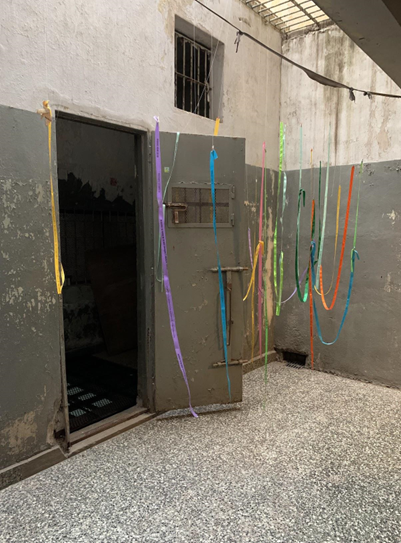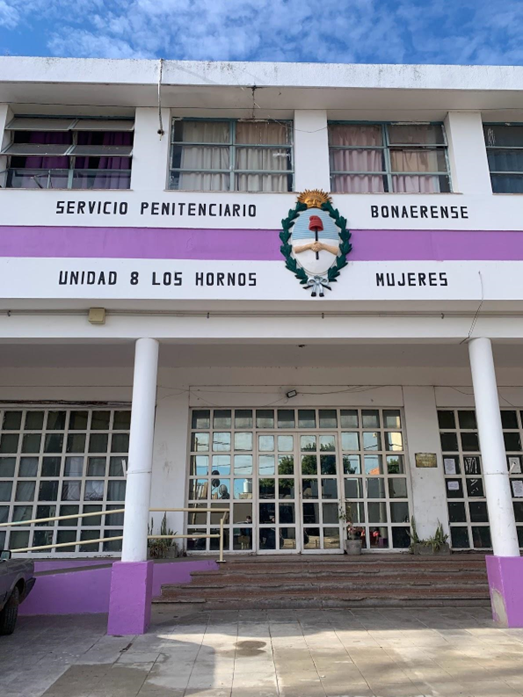
I spent my final weeks in La Plata working with the Programa Salud Mental and the Programa de intervenciones complejas y colectivas (PICC). On my first day working with the Salud Mental team, I met with my direct supervisor, Melina. She is phenomenal.
In the previous weeks, I had mentioned that I wanted to work with the Salud Mental team, but as they are a very new aspect of the CPM, I did not know if that would be possible. However, in the final weeks, I had the opportunity to work with the Salud Mental team, and I could not be more pleased with my experience. The individuals encompassing this team -as true with all of the people I met within the CPM- were incredibly welcoming. Their kindness and patience helped me adjust to the often-heavy topics we covered.
In preparation for an interview, I researched a man diagnosed with schizophrenia. I read his information from past interviews and tribunal proceedings in Savit. His mother was significantly involved in his case and routinely visited the CPM to see how her son’s case was progressing. This man’s case exemplified faults within mental health care, especially how it compares to law. Victims are not receiving adequate treatment, and unless their families are heavily involved -outside of the CPM- there are no safeguards to enforce the Right to Mental Health Protection (law 26.657) and Patient Rights in their Relationships with Health Professionals and Institutions (law 26.529).

The Salud Mental team is documenting how each case evolves, which is crucial in implementing change. By having longevity in their data recorded through Savit, the CPM can use this to institute necessary changes.
Two mental health team members and I visited Neuropsychiatric Hospital Unidad 34 to conduct interviews. This hospital was medium-security; inside, it looked and functioned like a prison. Upon arrival, the subdirector brought us into his office to discuss the hospital and our reason for being there. He said that this facility has no sobrepoblación (overpopulation). Everything I observed in the subdirector’s office, the hospital exterior, and the courtyard was well-kept and clean. This neuropsychiatric hospital is only for men, and the staff varies in gender. Inside the neuropsychiatric hospital was a waiting vestibule with numerous paintings and sculptures. While waiting for admittance into the interview room, my supervisors pointed out that the art and the courtyard were not accessible to those within the neuropsychiatric hospital.
The interview room was old and dirty; it did not have a sufficient door to ensure privacy. Similar to the interview room in the women’s annex in UP N૦ 8, the door to the interview room did not shut. Additionally, the window on the door had no glass, meaning the officers who sat just feet away were privy to every word.
During the visit, we could only interview one of the victims, as the man diagnosed with schizophrenia was with his therapist and was not present. The man we interviewed expressed his need for a specific diet as he had a colostomy (stomach bag) that sometimes made it challenging to eat solid foods. He wanted access to a liquid diet when necessary. Unfortunately, the staff were not cooperative with his needs as he had not yet been physically diagnosed with requiring this specific diet. Additionally, he mentioned that his room is very humid and experiences a range of extreme temperatures; this is concerning as it can create problems in sleep cycles, leading to mental health problems in the future. Therefore, the Salud Mental team keeps a detailed log of this man in Savit, as this case can alter, and he may require their aid.
Following the interview, I read the post-informe written by one of my colleagues on the Mental Health Team. I added information about the victim’s need for a liquid diet and how the team needed to maintain a close watch on that in the future; this will remain in Savit as formal documentation about this victim’s history. Since the Mental Health team was so new and made up of a small group, I could garner a lot of information and work directly with my supervisors, which was invaluable to me. I mentioned to my supervisor, Mercedes, that working with this team should be necessary for future internship cohorts as it offered a very engaging opportunity to see first-hand how mental health law functions in a different country.
My time with the PICC team (Programa de intervenciones complejas y colectivas) was short; however, very interesting. I read four ongoing case studies of victims and how they are being impacted by Argentina’s penal system. Of these cases, I recall one quite clearly. When an incarcerated woman went to the hospital to have her child, she was forced to leave her child behind since the child had a heart defect while she returned to prison. Another incarcerated woman was diagnosed with stage-4 cancer; she is in a lot of pain and has a nonexistent quality of life. PICC is working to get her released from prison to serve the rest of her life and prison sentence in her home.
The day after this, my cohort visited former Police Station N૦ 1 in Pergamino. This site of memory is for the seven men who died during a protest in which they lit a piece of their prison mattress on fire. Unfortunately, the bed was flammable, and the police officers did nothing to help and delayed calling for aid. All of the men in the cell died.
Following this visit marked the conclusion of my internship. It was bittersweet as I immensely enjoyed working at the CPM. During my time in Argentina, my Spanish fluency grew exponentially. I am very grateful to every member of the CPM who was so gracious and patient as I learned new vocabulary words and colloquialisms. Leaving my homestay was a tough goodbye; it felt like leaving my family behind. I adore them, and I am incredibly grateful for all they did for me during my stay and to William & Mary for allowing me to pursue this unparalleled opportunity.
Adiós Argentina, hasta la próxima.




The image of the church, El Ateneo, and Two Dancers in Yellow and Pink by Edgar Degas (exhibited in the National Museum of Fine Arts Buenos Aires) were all seen during a tour of Buenos Aires that the CPM took my cohort on.




Inside the Pergamino former police station, a site of memory to memorialize the seven men who died here due to state negligence. As you can see, the ceiling and outside the building are covered in soot from the deadly fire.






In my last week I got a haircut (at Alaska Peluquería) -the ultimate test in Spanish fluency. I absolutely love it!






























